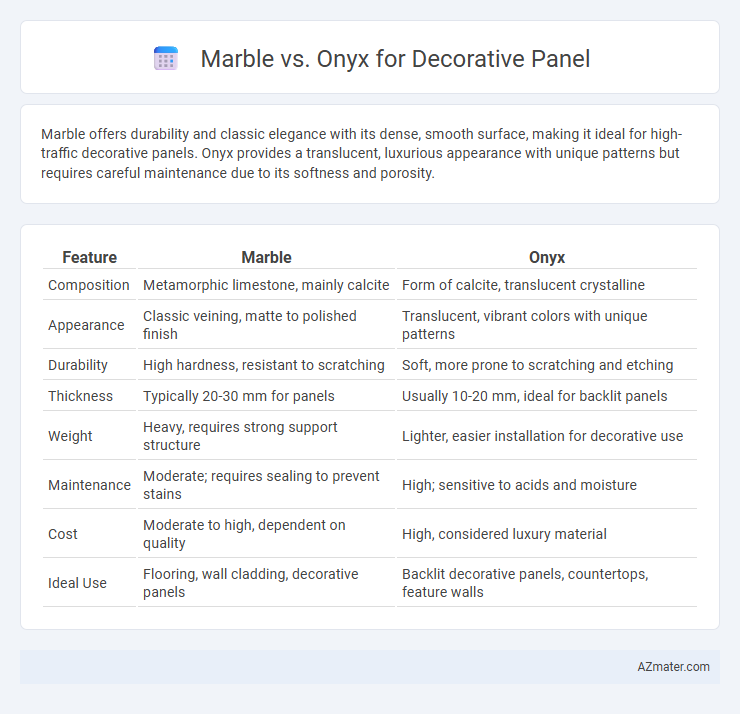Marble offers durability and classic elegance with its dense, smooth surface, making it ideal for high-traffic decorative panels. Onyx provides a translucent, luxurious appearance with unique patterns but requires careful maintenance due to its softness and porosity.
Table of Comparison
| Feature | Marble | Onyx |
|---|---|---|
| Composition | Metamorphic limestone, mainly calcite | Form of calcite, translucent crystalline |
| Appearance | Classic veining, matte to polished finish | Translucent, vibrant colors with unique patterns |
| Durability | High hardness, resistant to scratching | Soft, more prone to scratching and etching |
| Thickness | Typically 20-30 mm for panels | Usually 10-20 mm, ideal for backlit panels |
| Weight | Heavy, requires strong support structure | Lighter, easier installation for decorative use |
| Maintenance | Moderate; requires sealing to prevent stains | High; sensitive to acids and moisture |
| Cost | Moderate to high, dependent on quality | High, considered luxury material |
| Ideal Use | Flooring, wall cladding, decorative panels | Backlit decorative panels, countertops, feature walls |
Introduction to Marble and Onyx Decorative Panels
Marble and onyx decorative panels are premium materials widely used in interior design for their unique aesthetic appeal and durability. Marble panels feature a classic, veined pattern with a hard, sturdy surface ideal for high-traffic areas, while onyx panels offer a translucent quality that creates a luxurious, glowing effect when backlit, enhancing ambiance in residential and commercial spaces. Both materials vary in color, texture, and price, making them versatile options for sophisticated wall cladding, countertops, and accent features.
Unique Aesthetic Qualities of Marble
Marble offers a timeless elegance characterized by its smooth, polished surface and distinctive veining patterns that vary from subtle to dramatic, creating a luxurious visual impact for decorative panels. Its natural crystalline structure enhances light reflection, adding depth and dimension to interiors. Unlike onyx, marble's durability and classic appeal make it a preferred choice for sophisticated, long-lasting decorative applications.
Distinctive Appearance of Onyx Panels
Onyx panels showcase a translucent quality and vibrant color patterns that create a luxurious and unique visual appeal, setting them apart from the more opaque and uniform appearance of marble. The intricate veins and natural illumination of onyx enhance interior spaces with a dramatic depth and warmth. This distinctive aesthetic makes onyx panels a preferred choice for designers seeking exclusive and eye-catching decorative surfaces.
Durability and Maintenance Comparison
Marble offers superior durability for decorative panels due to its hardness and resistance to scratches and stains, making it suitable for high-traffic areas. Onyx, while visually striking with its translucent patterns, is softer and more prone to scratches, requiring more delicate handling and frequent sealing to maintain its appearance. Maintenance for marble involves regular cleaning with pH-neutral products, whereas onyx demands careful upkeep to prevent etching and damage from acidic substances.
Cost Differences Between Marble and Onyx
Marble typically costs between $40 and $100 per square foot, making it a more affordable option for decorative panels compared to onyx, which ranges from $100 to $250 per square foot due to its rarity and translucency. The installation costs for onyx panels are also higher, reflecting the material's fragility and the precision required in handling. Budget considerations often favor marble for large-scale projects, while onyx is chosen for high-end applications where cost is less restrictive.
Light Transmission and Backlighting Effects
Onyx exhibits superior light transmission compared to marble, allowing backlighting to create dramatic, translucent effects that highlight its natural veining and color variations. Marble, being denser and less translucent, provides only subtle light diffusion, resulting in a more subdued and opaque appearance under backlighting. Choosing onyx for decorative panels maximizes visual impact through vibrant illumination, while marble offers a classic, solid aesthetic with limited light interplay.
Versatility in Interior Design Applications
Marble offers timeless elegance and durability, making it ideal for versatile interior design applications such as flooring, countertops, and accent walls. Onyx, with its translucent quality and unique veining, provides a striking visual impact perfect for backlit panels and decorative features in luxury spaces. Both stones enhance interiors with their distinct textures and colors, but marble's broader range of finishes and resilience make it more adaptable for diverse design styles.
Environmental Impact and Sustainability
Marble and onyx differ significantly in environmental impact and sustainability for decorative panels; marble extraction typically involves less energy-intensive processes compared to onyx, which is rarer and often requires more extensive quarrying. Marble's abundant availability allows for more efficient sourcing and lower carbon emissions over its lifecycle, while onyx's limited reserves and higher fragility increase environmental costs. Choosing marble can contribute to more sustainable building practices due to its durability and lower ecological footprint in raw material extraction and transportation.
Installation Challenges and Considerations
Marble decorative panels demand precise handling due to their heavier weight and susceptibility to chipping during installation, requiring skilled labor and sturdy substructures. Onyx panels, while lighter and translucent for backlighting effects, are more fragile and prone to cracking, necessitating careful cutting and secure mounting to avoid damage. Both materials require moisture-resistant backing and appropriate sealants to preserve their aesthetic appeal and structural integrity in interior applications.
Which Material is Best for Your Decorative Panel Project?
Marble offers exceptional durability and a classic, timeless look with unique veining patterns, making it ideal for high-traffic decorative panels that require longevity. Onyx provides a translucent, luxurious appearance with vibrant colors and backlighting potential, perfect for creating dramatic, artistic focal points in interior designs. Choosing the best material depends on whether the project prioritizes strength and tradition with marble or artistic elegance and light diffusion with onyx.

Infographic: Marble vs Onyx for Decorative Panel
 azmater.com
azmater.com